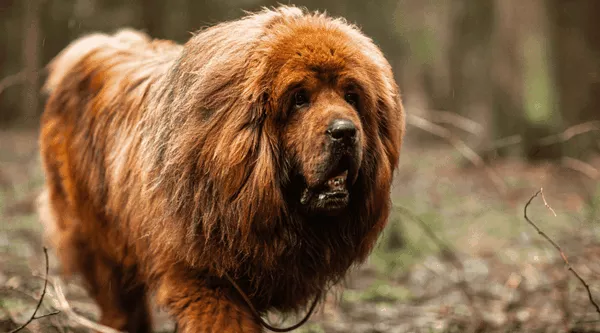The majestic and imposing Tibetan Mastiff has long captured the admiration of dog enthusiasts worldwide. Known for its noble stature and unwavering loyalty, this ancient breed has a rich history that stretches back thousands of years. In this article, we delve into the fascinating evolution of the Tibetan Mastiff, exploring its origins, historical significance, and the unique traits that have made it a cherished companion and guardian.
The Himalayan Homeland
Bold Beginnings in the Roof of the World
The Tibetan Mastiff, often referred to as the “Do-khyi” in its native Tibetan language, traces its roots to the harsh and rugged landscapes of the Himalayan region. Nestled in the high-altitude plateaus of Tibet, Bhutan, and Nepal, this breed has adapted to extreme climatic conditions and has been an integral part of the pastoral communities in the area for centuries.
Guardians of the Nomadic Tribes
Historically, Tibetan Mastiffs played a crucial role in the lives of nomadic Tibetan tribes. Bred primarily as guardian dogs, they protected livestock, monasteries, and homes from predators such as wolves, leopards, and bears. Their imposing size, thick double coat, and keen instincts made them indispensable assets to these communities, earning them a revered status.
Genetic Ancestry
The Genetic Tapestry of the Tibetan Mastiff
Unraveling the genetic origins of the Tibetan Mastiff adds another layer to its captivating story. DNA studies have revealed that this breed belongs to the mastiff family, with a close relationship to other large working breeds such as the Saint Bernard and Bernese Mountain Dog. Despite these connections, the Tibetan Mastiff stands out due to its unique adaptations to the Himalayan environment.
Isolation and Preservation of the Breed
Geographical isolation played a crucial role in shaping the genetic profile of the Tibetan Mastiff. The challenging terrain and sparse human population in Tibet limited crossbreeding, leading to a remarkably pure and distinctive breed. This isolation not only contributed to the preservation of the breed’s original characteristics but also gave rise to the diverse coat colors and patterns observed in Tibetan Mastiffs today.
Historical Significance
Guardians of the Dalai Lama: A Symbol of Prestige
Tibetan Mastiffs gained prominence beyond their working roles as guardians. In Tibetan culture, these dogs were highly valued and often presented as gifts to dignitaries and leaders. The Dalai Lama, in particular, was known to have Tibetan Mastiffs in his retinue, further elevating the breed’s status as a symbol of prestige and power.
Silent Sentinels: Monastery Protectors
Monasteries, integral to Tibetan culture and spirituality, found loyal protectors in Tibetan Mastiffs. The dogs were not only guardians of the monks but were also believed to possess spiritual significance. Legends tell of these canines being reincarnated monks, entrusted with the duty of safeguarding the sacred spaces from both physical and metaphysical threats.
Adaptations to the Environment
Surviving the High Altitudes: Physical Characteristics
The Tibetan Mastiff’s adaptation to the challenging Himalayan environment is evident in its physical characteristics. The breed’s large, muscular build and thick double coat serve as insulation against the harsh cold, while the distinctive mane around the neck provides protection from potential predators. The well-feathered tail can be wrapped around the body during rest, offering an extra layer of warmth.
Independent Thinkers: Mental Traits
Beyond physical attributes, the Tibetan Mastiff is renowned for its intelligence and independent nature. These dogs are known to be highly alert and possess strong territorial instincts, making them exceptional guardians. Their ability to assess situations independently and act accordingly has been honed through generations of working alongside Tibetan nomads.
Cultural Impact and Global Recognition
From Tibet to the World: International Recognition
While the Tibetan Mastiff has been a revered presence in its homeland for centuries, it wasn’t until the mid-20th century that the breed gained international attention. Explorers, diplomats, and traders returning from Tibet brought tales of these magnificent dogs, fueling curiosity and admiration in the Western world. This led to the first imports of Tibetan Mastiffs into Europe and North America.
See Also:Will a Tibetan Mastiff Beat a Wolf?
Pop Culture and Modern Allure
In recent decades, the Tibetan Mastiff has found its way into popular culture, making appearances in films, television shows, and even celebrity homes. The breed’s distinctive appearance and historical significance have contributed to its allure, attracting dog enthusiasts and collectors alike. However, the increasing demand for Tibetan Mastiffs has raised concerns about the preservation of the breed’s authenticity and well-being.
Challenges and Conservation Efforts
Balancing Tradition and Modern Demands
As the Tibetan Mastiff gains popularity globally, the breed faces challenges that threaten its purity and well-being. The demand for these majestic dogs has led to indiscriminate breeding, often compromising the breed’s health and temperament. Striking a balance between meeting the demands of modern pet ownership and preserving the breed’s traditional characteristics is a delicate task.
Conservation Initiatives: Preserving Heritage
Various organizations and breed enthusiasts are actively engaged in conservation efforts to safeguard the Tibetan Mastiff’s heritage. Initiatives include responsible breeding practices, education on the breed’s specific needs, and advocacy for ethical treatment and care. Collaborative efforts between breeders, veterinarians, and cultural preservationists aim to ensure the continued well-being and authenticity of this ancient breed.
Conclusion
In conclusion, the evolution of the Tibetan Mastiff is a captivating tale of adaptation, cultural significance, and unwavering loyalty. From the nomadic tribes of Tibet to the homes of dog enthusiasts worldwide, this majestic breed continues to leave an indelible mark on the hearts of those who encounter it. As we navigate the delicate balance between tradition and modern demands, it is imperative to uphold the integrity of the Tibetan Mastiff, preserving its unique traits and the cultural heritage it represents. In doing so, we honor not only the breed’s past but also ensure a vibrant and authentic future for this ancient and noble companion.
Related Topics:
Why Tibetan Mastiffs Sold for a Million Dollars?
Why Tibetan Mastiffs Face Bans?
Why Is Tibetan Mastiff Popular in China?


























